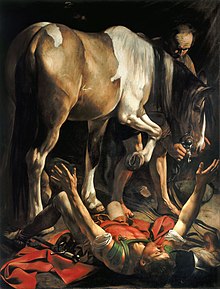
Back رسائل بولس Arabic رسايل بولس ARZ Paulinische Briafe BAR Лісты апостала Паўла Byelorussian Пасланьні Паўла BE-X-OLD পৌলের পত্র Bengali/Bangla Lizheroù Paol Breton Epístoles Paulines Catalan Pavlovy epištoly Czech Llythyrau Paul Welsh
| Part of a series of articles on |
| Paul in the Bible |
|---|
 |
| Events in the Life of Paul according to Acts of the Apostles |
|---|
 |
|
The Pauline epistles, also known as Epistles of Paul or Letters of Paul, are the thirteen books of the New Testament attributed to Paul the Apostle, although the authorship of some is in dispute. Among these epistles are some of the earliest extant Christian documents. They provide an insight into the beliefs and controversies of early Christianity. As part of the canon of the New Testament, they are foundational texts for both Christian theology and ethics.
Most scholars believe that Paul actually wrote seven of the thirteen Pauline epistles (Galatians, Romans, 1 Corinthians, 2 Corinthians, Philemon, Philippians, 1 Thessalonians), while three of the epistles in Paul's name are widely seen as pseudepigraphic (1 Timothy, 2 Timothy, and Titus).[1] Whether Paul wrote the three other epistles in his name (2 Thessalonians, Ephesians and Colossians) is widely debated.[1] According to some scholars, Paul wrote the questionable letters with the help of a secretary, or amanuensis,[2] who would have influenced their style, if not their theological content. The Epistle to the Hebrews, although it does not bear his name, was traditionally considered Pauline (although Rome questioned its authorship), but from the 16th century onwards opinion steadily moved against Pauline authorship and few scholars now ascribe it to Paul, mostly because it does not read like any of his other epistles in style and content and because the epistle does not indicate that Paul is the author, unlike the others.[3]
A number of scholars have argued that from biographic details from Paul, he likely suffered from some physical impediment such as vision loss or damaged hands and Paul does explicitly state, or even names, in multiple epistles that he used secretaries, which was a common practice in the Greco-Roman world; likely explaining the epistles that are seemingly non-Pauline.[4][5][6][7]
The Pauline epistles are usually placed between the Acts of the Apostles and the catholic epistles (also called the general epistles) in modern editions. Most Greek manuscripts place the general epistles first,[8] and a few minuscules (175, 325, 336, and 1424) place the Pauline epistles at the end of the New Testament.
- ^ a b New Testament Letter Structure, from Catholic Resources by Felix Just, S.J.
- ^ Richards, E. Randolph. Paul and First-Century Letter Writing: Secretaries, Composition and Collection. Downers Grove, IL; Leicester, England: InterVarsity Press; Apollos, 2004. [page needed]
- ^ The New Jerome Biblical Commentary, publ. Geoffrey Chapman, 1989, chapter 60, at p. 920, col. 2 "That Paul is neither directly nor indirectly the author is now the view of scholars almost without exception. For details, see Kümmel, I[ntroduction to the] N[ew] T[estament, Nashville, 1975] 392–94, 401–03"
- ^ Moss, Candida R (29 April 2023). "The Secretary: Enslaved Workers, Stenography, and the Production of Early Christian Literature". The Journal of Theological Studies. 74 (1): 20–56. doi:10.1093/jts/flad001.
- ^ Blumell, Lincoln H. (2006). "Scribes and Ancient Letters Implications for the Pauline Epistles". Brigham Young University. How the New Testament Came to Be: The Thirty-fifth Annual Sidney B. Sperry Symposium, ed. p. 208-226.
- ^ Marshall, Dr Taylor (30 January 2015). "The Secretaries of Peter, Paul and John". Taylor Marshall.
- ^ Richards, E. Randolph (1991). The Secretary in the Letters of Paul. Mohr Siebeck. ISBN 3161455754.
- ^ Metzger, Bruce M. (1987). The Canon of the New Testament: Its Origin, Development, and Significance (PDF). pp. 295–96. ISBN 0198261802. Archived from the original (PDF) on 2013-06-01.